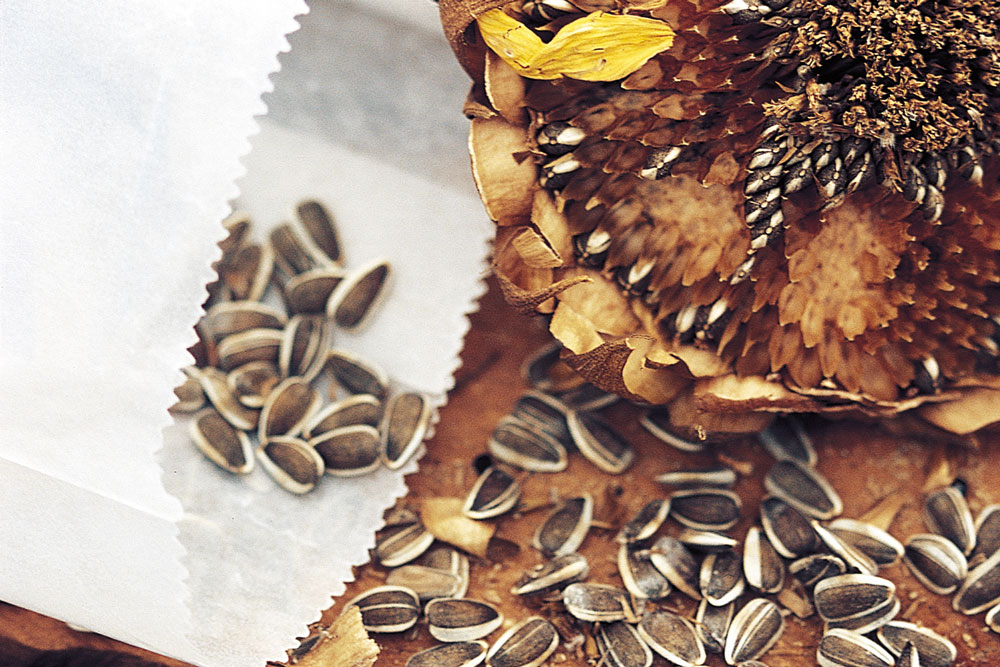
Saving seeds used to be the way to pass plants down from generation to generation. These days seeds are widely available, so you don’t save them out of necessity.
It’s more a way to share plants with other gardeners, maintain your favourites or experiment with hybrids.
If you want to grow flowers that look like their parents, save seeds from heirloom or old-fashioned varieties, and open-pollinated plants.
The seeds from hybrid plants are likely to be variable and can also be inferior to the parent plant.
To find seeds, look behind fading flowers for pods, capsules or fruits. The seeds can be tiny dots or the size of a fingernail, depending on the variety.
Harvest the seed head after it has matured but before it drops.
Collect the seeds of dry flowers, then save or plant in a medium such as horticultural perlite.
Collecting seeds
Annuals
Gather the seed heads of annuals from midsummer before they’re fully ripe and start shedding, and save them for sowing next season.
CUT OFF the seed heads as soon as they look dry or start to change colour, and invert into paper bags.
TIE THE BAGS around the stems and hang them upside down in a dry, airy place to finish ripening.
SHAKE OUT the dry seeds after a week or two, gently blow away the chaff and store them in labelled envelopes in an airtight tin away from extreme cold and heat.
SOW THE SEEDS in spring in trays or directly into garden beds.

Gather the seed heads of annuals from midsummer before they’re fully ripe and start shedding, and save them for sowing next season
Perennials
Many hardy perennials can be raised from collected seed. Save the seeds or plant out in beds and cover with mulch and they’ll emerge in spring.
CUT OFF the seed heads as soon as they turn brown, showing they are ripe, and remove the seeds or cover with a paper bag and shake.
STORE THE SEEDS in paper bags, envelopes or plastic containers. Don’t use plastic bags as the seeds might rot. Label each container with the plant name and collection date.
SOW THE SEEDS into pots or trays of moist potting mix and cover with a thin layer of perlite. Stand pots in a sheltered spot outside.

Many hardy perennials can be raised from collected seed. Save the seeds or plant out in beds and cover with mulch and they’ll emerge in spring
Helping germination
Most perennials are suitable for sowing immediately, but certain varieties need special treatment in order to germinate.
The seeds of trees, sweet peas and other flowering legumes have a hard coating that needs to be chipped with a sharp knife or rubbed with abrasive paper to allow water to penetrate.
Other flower varieties such as hibiscus, lobelia, rudbeckia, cyclamen, delphinium and primula, require a cold period of dormancy. Pretreating seeds to simulate this period is called stratification.
Mix the seeds with damp potting mix or perlite in a plastic bag and refrigerate for several weeks, then sow in the autumn.
Store the seeds
Even when fully dried, seeds remain living organisms with a limited lifespan, so store them carefully to keep them in peak condition.
Separate dry seeds from their casings and other seed-head fragments by hand picking, sieving or blowing away debris.
Seal the seeds in paper envelopes labelled with the name, date and origin, and pack them in an airtight container. Or you can also use old lidded film canisters.
Prevent dampness, the greatest enemy of stored seeds, by including sachets of silica gel in the container. Silica gel absorbs moisture and also turns pink in its presence.
Keep the seeds in a cool place where they are not exposed to fluctuating temperatures.
Any surplus bought seeds remaining in opened packets can be stored in exactly the same way.
TIP You can dry the sachets gently in a very low oven until the silica gel is blue again, then re-use them.

Gather sunflower seeds once the large flowerheads turn brown and dry. Image: Thinkstock
Plants for easy seeds collection
Annuals
- Impatiens
- Nasturtium
- Poppy
- Snapdragon
Perennials
- Aquilegia
- Dianthus
- Hollyhock
- Verbena

